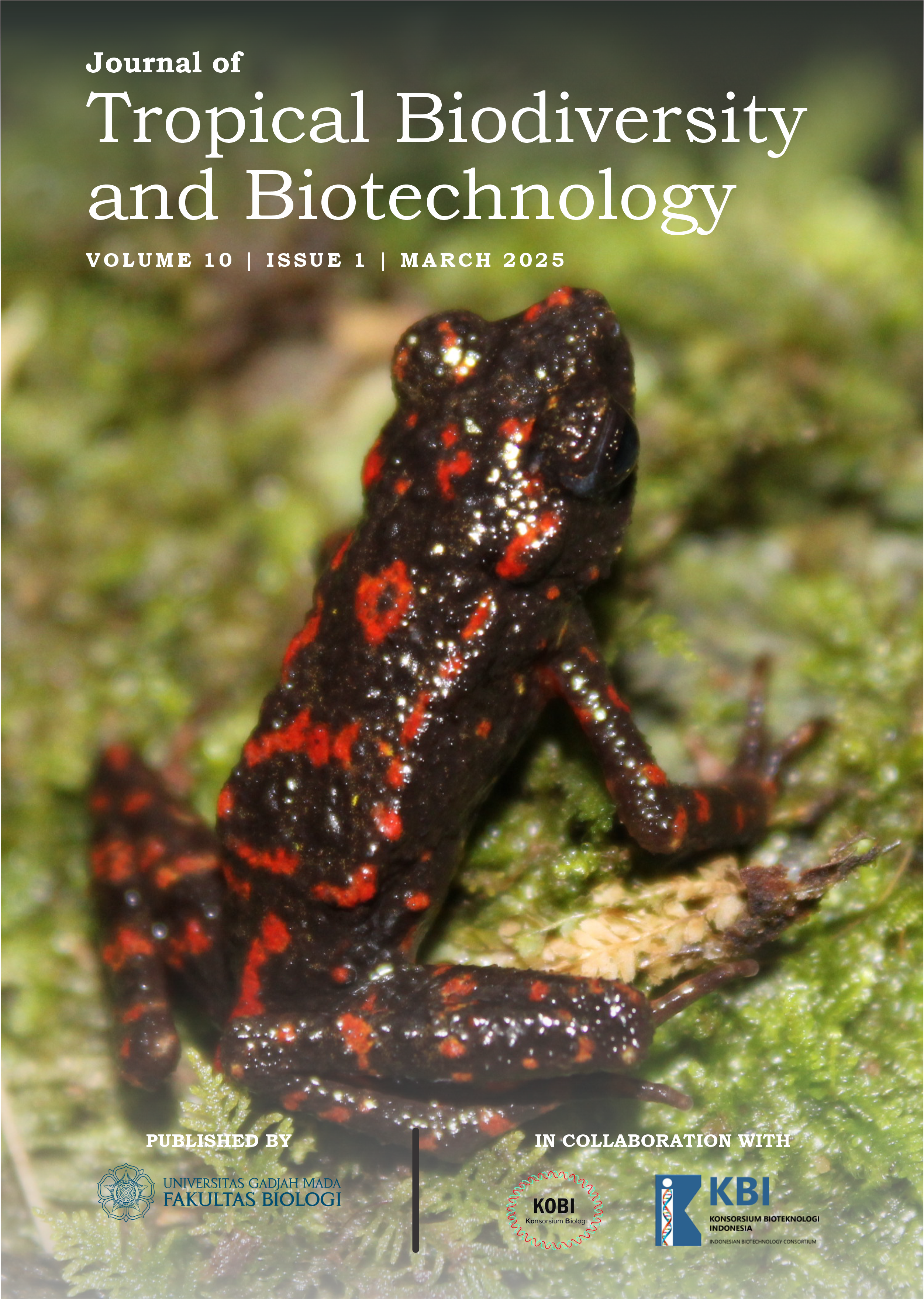From Bean to Biosphere: Vegetation Dynamics and Biodiversity in Arabica Coffee Agroforestry at Ijen Geopark
Abstract
This study evaluates vegetation biodiversity and ecological conditions at the Bondowoso Biosite of Kebun Kopi, Ijen Geopark, to support sustainable Arabica coffee production. Three agroforestry plots (KR1-3) and a plantation plot (PN) were analyzed for species composition. In KR1, Acacia auriculiformis (IVI=110) and Trema orientalis (IVI=190) are prominent. KR2 is dominated by A. auriculiformis (IVI=160) and Ricinus communis (IVI=80), while Casuarina equisetifolia is significant in KR3. The PN plot shows a more even IVI distribution between Falcataria mollucana and Grevillea robusta. Tukey's test reveals significant differences between KR1 and PN, and KR2 and PN plots (p-adj=0.001). The highest existence values are Anisoptera marginata (66.67%) in KR1, T. orientalis (53.33%) in KR2, C. equisetifolia (46.67%) in KR3, and Toona sureni (26.67%) in PN. Results indicate significant variations in species diversity, evenness, and dominance across plots, influenced by ecological, geographical, and anthropogenic factors. Higher Shannon-Wiener and Evenness indices in KR1 and KR2 suggest diverse species compositions are vital for ecosystem health, while KR3's dominance of few species highlights the need for biodiversity conservation. This research recommends regenerative Arabica coffee farming practices and sustainable conservation strategies at the Bondowoso Biosite of Kebun Kopi.
References
Ambas, A.D. et al., 2024. Falcataria moluccana (Miq.) root distribution seedlings in response to nitrogen concentrations and tillage. Folia Oecologica, 51(1), pp.47–55. doi: 10.2478/foecol-2024-0005.
Andika, T.R. & Wicaksono, K. P., 2020. Characteristics of Physilogy and Growth of Arabica Coffee (Coffea arabica) Plants in Different Management in Agroforestry Fields. Jurnal Produksi Tanaman, 8(1), pp.106–111.
Anhar, A. et al., 2021. Altitude, shading, and management intensity effect on Arabica coffee yields in Aceh, Indonesia. Open Agriculture, 6(1), pp.254–262. doi: 10.1515/opag-2021-0220.
Aronson, M.F.J. et al., 2014. A global analysis of the impacts of urbanization on bird and plant diversity reveals key anthropogenic drivers. Proceedings of the Royal Society B: Biological Sciences, 281(1780), pp.1–8. doi: 10.1098/rspb.2013.3330.
Atangana, A. et al., 2014. Tropical agroforestry. In Tropical Agroforestry. Springer Science Business Media, pp.173–202. doi: 10.1007/978-94-007-7723-1.
Azad, M.S. & Sumon, M.M.H., 2016. Species Specific Responses to Age on Nodule Formation, Seedling Growth, and Biomass Production of Acacia auriculiformis at Nursery Stage. Journal of Botany, 2016, pp.1–8. doi: 10.1155/2016/6960783.
Boğan, M. et al., 2020. Stranger in the garden: Ricinus communis, 17 cases of intoxication. Hong Kong Journal of Emergency Medicine, 27(5), pp.308–312. doi: 10.1177/1024907919846720.
Brearley, F.Q., Banin, L.F. & Saner, P., 2016. The ecology of the Asian dipterocarps. Plant Ecology and Diversity, 9(5–6), pp.429–436. doi: 10.1080/17550874.2017.1285363.
Carvalho, J.M., Paiva, E.L. & Vieira, L.M., 2016. Quality attributes of a high specification product: Evidences from the speciality coffee business. British Food Journal, 118(1), pp.132–149. doi: 10.1108/BFJ-02-2015-0059.
Cerda, R. et al., 2017. Effects of shade, altitude and management on multiple ecosystem services in coffee agroecosystems. European Journal of Agronomy, 82, pp.308–319. doi: 10.1016/j.eja.2016.09.019.
Ellis, E.C., 2015. Ecology in an anthropogenic biosphere. Ecological Monographs, 85(3), pp.287–331. doi: 10.1890/14-2274.1.
Haggar, J. et al., 2017. Environmental-economic benefits and trade-offs on sustainably certified coffee farms. Ecological Indicators, 79, pp.330–337. doi: 10.1016/j.ecolind.2017.04.023.
Hasan, F. & Ningrum, I.H., 2023. Exploration of the Potential Geosite of Ijen Geopark Bondowoso Region as an Educational Tourism. Jurnal Kepariwisataan: Destinasi, Hospitalitas Dan Perjalanan, 7(2), pp.196–205. doi:10.34013/jk.v7i2.1215.
Khan, L., 2016. Importance value indices of various weeds and their management in turf grass. Pure and Applied Biology, 5(4), pp.804–814. doi: 10.19045/bspab.2016.50101.
Kvålseth, T.O., 2015. Evenness indices once again: critical analysis of properties. Springer Plus, 4(232), pp.1–12. doi: 10.1186/s40064-015-0944-4.
Nesper, M. et al., 2019. Simplification of shade tree diversity reduces nutrient cycling resilience in coffee agroforestry. Journal of Applied Ecology, 56(1), pp.119–131. doi: 10.1111/1365-2664.13176.
Ngoan, T.T. et al., 2023. Models for biomass expansion factor of acacia hybrid (A. auriculiformis* A. mangium) plantations in the Southern region, Vietnam. Journal of Forestry Science and Technology, 8(2), pp.138–146. doi: 10.55250/jo.vnuf.8.2.2023.138-146.
Permanadewi, S. et al., 2024. Quantitative assessment for geosites of the Ijen Geopark in Banyuwangi Regency, East Java, Indonesia. International Journal of Geoheritage and Parks, 12(1), pp.63–74. doi: 10.1016/j.ijgeop.2024.01.003.
Rodrigues, C.R. & Rodrigues, B.F., 2014. Enhancement of Seed Germination in Trema orientalis (L.) Blume-Potential Plant Species in Revegetation of Mine Wastelands. Journal of Sustainable Forestry, 33(1), pp.46–58. doi: 10.1080/10549811.2013.807745.
Saddiqe, Z., Nazir, A. & Sabir, M., 2020. Allelopathic efect of Ricinus communis L. extracts on germination and seedling growth of Zea mays L. Journal of Natural and Applied Sciences Pakistan, 2(1), pp.232–242.
Sandifer, P.A., Sutton-Grier, A.E. & Ward, B.P., 2015. Exploring connections among nature, biodiversity, ecosystem services, and human health and well-being: Opportunities to enhance health and biodiversity conservation. Ecosystem Services, 12, pp.1–15. doi: 10.1016/j.ecoser.2014.12.007.
Sauvadet, M. et al., 2019. Shade trees have higher impact on soil nutrient availability and food web in organic than conventional coffee agroforestry. Science of the Total Environment, 649, pp.1065–1074. doi: 10.1016/j.scitotenv.2018.08.291.
Sharma, M. et al., 2023. Factors influencing pollinator abundance in Indigenous coffee farms of the Nilgiris, Western Ghats, India. Ann. Entomol, 37(02), pp.137–143. doi: 10.21203/rs.3.rs-2485017/v1.
Strong, W.L., 2016. Biased richness and evenness relationships within Shannon-Wiener index values. Ecological Indicators, 67, pp.703–713. doi: 10.1016/j.ecolind.2016.03.043.
Sulistyowati, H., 2008. Analisis Status Flora Cagar Alam Pulau Sempu , Kabupaten Malang Status A. Jurnal Ilmu Dasar, 9(1), pp.78–81.
Udawatta, R.P., Rankoth, L.M. & Jose, S., 2019. Agroforestry and biodiversity. Sustainability (Switzerland), 11(2879), pp.1–22. doi: 10.3390/su11102879.
Sikuzani, Y.U. et al., 2024. The Restoration of Degraded Landscapes along the Urban–Rural Gradient of Lubumbashi City (Democratic Republic of the Congo) by Acacia auriculiformis Plantations: Their Spatial Dynamics and Impact on Plant Diversity. Ecologies, 5(1), pp.25–41. doi: 10.3390/ecologies5010002.
Van Loon, W.M.G.M. et al., 2018. A regional benthic fauna assessment method for the Southern North Sea using Margalef diversity and reference value modelling. Ecological Indicators, 89, pp.667–679. doi: 10.1016/j.ecolind.2017.09.029.
Widiyono, W., 2021. Biological and economic values of Dipterocarpaceae, the main timber forest product of Indonesia. Indonesian Journal of Applied Environmental Studies, 2(2), pp.104–112. doi: 10.33751/injast.v2i2.4016.
Wilson, M.H. & Lovell, S.T., 2016. Agroforestry-The next step in sustainable and resilient agriculture. Sustainability (Switzerland), 8(6), pp.1–15. doi: 10.3390/su8060574.




